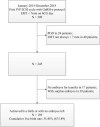Cumulative Live Birth Rate in Patients With Thin Endometrium: A Real-World Single-Center Experience
- PMID: 33013679
- PMCID: PMC7509444
- DOI: 10.3389/fendo.2020.00469
Cumulative Live Birth Rate in Patients With Thin Endometrium: A Real-World Single-Center Experience
Abstract
Background: Studies have shown that patients with a thin endometrial thickness (EMT < 7 or 8 mm) during IVF/ICSI tend to have adverse pregnancy outcomes, and this has caused much anxiety to both patients and physicians when confronted with a thin EMT. Method: From January 2015 to December 2018, patients with a thin EMT < 7 mm on the day of hCG administration during their first GnRH agonist IVF/ICSI cycle were included. According to the hysteroscopy results, patients were classified into totally normal (Group A), normal with a specific abnormality (Group B), and adhesion before transfer (Group C). Result: For the 245 patients included, approximately 60% of the thin EMT cases were the result of an intrauterine operation. CLBR was 35.45% (67/189) in this group of patients. In regard to CLBR, there were significant differences among these three uterus condition groups irrespective of the number of oocytes retrieved (28.57 vs. 10.00 vs. 4.76%, P = 0.12 in oocyte ≤5; 61.36 vs. 44.67 vs. 23.63%, P = 0.00 in oocyte >5). In binary logistic regression analysis, age (OR = 0.09, P = 0.03), number of embryos available (OR = 1.71, P = 0.00), and uterine condition (OR = 6.77, P = 0.00 for group A; OR = 2.55, P = 0.04 for group B; Reference = group C), were significantly associated with CLBR. However, EMT and endometrial pattern had no impact on CLBR. Conclusion: An intrauterine operation was the main reason for a thin EMT. Thin EMT patients with a normal uterine cavity and endometrium had a significantly better CLBR compared with those with adhesions before transfer.
Keywords: IVF; cumulative live birth rate; infertility; outcome; thin endometrium.
Copyright © 2020 Bu, Hu, Yang and Sun.
Figures
Similar articles
-
[Cumulative live birth rates per oocytes retrieved cycle: evaluation of clinical outcomes of IVF/ICSI].Zhonghua Fu Chan Ke Za Zhi. 2018 Mar 25;53(3):160-166. doi: 10.3760/cma.j.issn.0529-567X.2018.03.004. Zhonghua Fu Chan Ke Za Zhi. 2018. PMID: 29609229 Chinese.
-
The number of oocytes associated with maximum cumulative live birth rates per aspiration depends on female age: a population study of 221 221 treatment cycles.Hum Reprod. 2019 Sep 29;34(9):1778-1787. doi: 10.1093/humrep/dez100. Hum Reprod. 2019. PMID: 31398253
-
Cumulative live birth rates after one ART cycle including all subsequent frozen-thaw cycles in 1050 women: secondary outcome of an RCT comparing GnRH-antagonist and GnRH-agonist protocols.Hum Reprod. 2017 Mar 1;32(3):556-567. doi: 10.1093/humrep/dew358. Hum Reprod. 2017. PMID: 28130435 Clinical Trial.
-
The Effect of Endometrial Thickness on Pregnancy, Maternal, and Perinatal Outcomes of Women in Fresh Cycles After IVF/ICSI: A Systematic Review and Meta-Analysis.Front Endocrinol (Lausanne). 2022 Feb 11;12:814648. doi: 10.3389/fendo.2021.814648. eCollection 2021. Front Endocrinol (Lausanne). 2022. PMID: 35222264 Free PMC article.
-
Growth hormone cotreatment for poor responders undergoing in vitro fertilization cycles: a systematic review and meta-analysis.Fertil Steril. 2020 Jul;114(1):97-109. doi: 10.1016/j.fertnstert.2020.03.007. Epub 2020 Jun 16. Fertil Steril. 2020. PMID: 32553470
Cited by
-
Factors Affecting the Potential Efficacy of Intrauterine Platelet-Rich Plasma Infusion on Thin Endometrium in Women with Recurrent Implantation Failure.J Pers Med. 2023 Sep 21;13(9):1419. doi: 10.3390/jpm13091419. J Pers Med. 2023. PMID: 37763186 Free PMC article.
-
Endometrial thickness and live birth rates after IVF: a systematic review.Acta Biomed. 2023 Jun 14;94(3):e2023152. doi: 10.23750/abm.v94i3.14437. Acta Biomed. 2023. PMID: 37326261 Free PMC article.
References
Publication types
MeSH terms
LinkOut - more resources
Full Text Sources



